Common name: Carrot family or Celery or Parsley family or Umbelliferae
Number of genera: This family includes 434 genera and about 3700 species
Propagation type: Whole fruit or partial fruit
Distribution: The members of this family Apiaceae are distributed in most parts of the world. But they are commonly found in sub-tropical, north temperate regions. These plants are cultivated in India during winter season.
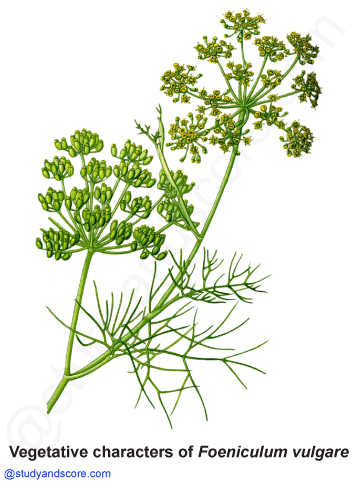
Habitat: Members of this family are adapted to conditions that encourage heavy concentrations of essential oils.
Habit: Most of this family are herbaceous annual, biennial (having a 2 year cycle), or perennial plants
Root system: These plants have tap root system. The roots are large enough to store the useful food materials. For example: carrot and parsnip.
Stem: Stems are hollow at the points where the leaves are attached. Usually stems are soft, green, aerial. Either prostrate or erect. Sometimes stems penetrate underground and store food materials. The nodes of the stem are swollen.
Leaf: Leaves are alternate, exstipulate, pinnately compound or palmately lobed with reticulate venation. Leaf petiole is broadened with sheath surrounding stem or base of leaf.
Inflorescence: Inflorescence is the characteristic feature of this family. The flowering head is usually a simple or compound ‘umbel’, but it can be reduced to a single flower in some species. This flat-topped umbel resembles a flattened umbrella structure and thus the alternate name for this family is Umbelliferae. The primary umbel is surrounded by an involucre of bracts and secondary umbel is subtended by an involucre of bractlets.
Flower:Flowers are small, bracteate/ebracteate, pedicillate or sessile, complete, regular, pentamerous, actinomorphic or zygomorphic, epigynous, cyclic usually bisexual and rarely unisexual. Flowers are arranged in umbels or double umbels, Flowers are many, small, white or yellow in color.
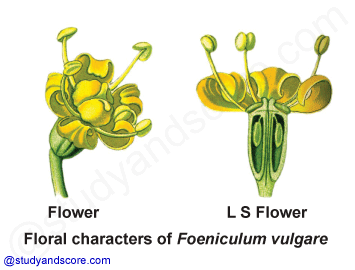
Calyx: The calyx consists of 5 sepals which remain adnate to the ovary wall. Sometimes sepals may be absent. The aestivation is valvate. The calyx is usually represented by five inconspicuous teeth.
Corolla:The corolla consists of 5 free petals alternating with sepals. Petals are usually apically inflexed in bud and they fall off soon. The aestivation is imbricate or valvate. The petals are two lobes. The peripheral flowers of Coriandrum have unequal petals.
Androecium: The Androecium consists of 5 free stamens, alternating with the petals. They arise from an epigynous disc. The filaments are equal in length, inflexed in bug and the anthers are basifixed or dorsifixed, dithecous, introse and dehisce longitudinally.
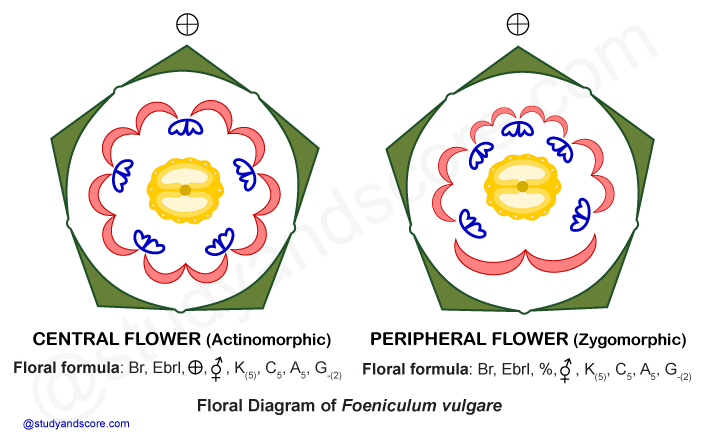
Gynoecium: The Gynoecium is bicarpellary and syncarpous with an inferior bilocular ovary. Each carpel has a single pendulous and anatropus ovule. The placentation is axile. An epigynous disc called as stylopodium, is present on the top of the ovary. Stylopodium surrounds the two styles. Stigmas are capitates and distinct. The carpels are ribbed and have parallel resinous canals called vittae.
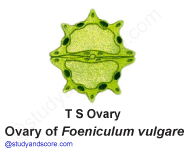
Pollination: Flowers are pollinated by a wide variety of insects – mostly flies, mosquitoes or gnats, bees, butterflies or moths.
Fruit: The fruit can be divided into 2 parts. The fruit is schizocarpic cremocarp. A cremocarp is made up of two one-seeded carpels called as mericarps. Mericarps remain attached to the central axis known as carpophore. Mericarps are longitudinally ridged and in between the ridges resinous or oil ducts called vittae are present.
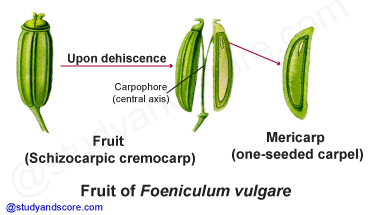
Seed: Seeds are endospermic with a small embryo. The endosperm may be flat, crescent or concave on the ventral side.
Family Apiaceae is also called as the carrot or celery or parsley family or Umbelliferae. The alternative name of this family is Umbelliferae. This family consists of mostly aromatic plants. This family has more than 434 genera and around 3,700 species. The members of this family are distributed throughout the world. Its members are characterized by hollow stems, taproots and flat-top flowers also known as umbels.
The following is a list of some important members of family Apiaceae, arranged alphabetically.
The family Apiaceae contributes several important food, essential oils and aromatic herbs to human race. Hence this family is considered as economically important.
Apium graveolens: It is cultivated in Himalayas, Uttaranchal, Himachal Pradesh and South India. It is used as a vegetable. Its roots and seeds are used medicinally. The fruits are used for extracting valuable oil and the seeds are used as spices.
Coriandrum sativum: It is chiefly grown in Madhya Pradesh, Maharashtra, Karnataka, Bihar and Uttar Pradesh. The fruits and leaves are used as condiment and spice. The fruit of this aromatic herb is used as stimulant, carminative, stomachic and tonic.
Cuminum cyminum: It is grown in the Punjab and Uttar Pradesh. This plant gives aromatic fruits which are used as flavoring agents.
Carum carvi: It is cultivated in Bihar, Orissa, the Punjab, Bengal and Andhra Pradesh. The fruits are used as condiment. Its fruits are also used as stomachic and carminative.
Bunium persicum: It is found in Kashmir. The starchy tubers are eaten as vegetable. Its seeds are used as spice.
Trachyspermum ammi: It is cultivated throughout India. Its fruits are used as spices. They are medicinally used as carminative, stimulant and tonic for indigestion.
Daucus carota: It is grown chiefly in the Punjab, Uttar Pradesh and Madhya Pradesh. The roots of this plant are edible.
Centella asiatica: It has a wide range of medical applications. It is used to cure cholera, madness and as medicine of few forms of leprosy.
Ferula species: Ferula asafoetida is grown in the Punjab and Kashmir. The gum-resin obtained from its roots is used in perfume industry. It is also used in flavoring food products. It also has medical application in treatment of asthma, cough and indigestion. Ferula galbaniflua gives an oleo gum resin. This resin from the stem is used in perfumery. It is also used in the treatment of chronic bronchitis and asthma. The roots and seeds of Ferula jaeschkena are used in the production of essential oil. Oleo-gum resin obtained from Ferula narthex is used for flavoring food products.
Anethum species: The fruits of Anethum graveolens are used as spice and condiment. They are also used as carminative.
The leaves of Anethum sowa are used for flavoring. Its fruits are used as carminative, stomachic and stimulant.
The roots of Pastinaca sativa are eaten as vegetable.
Seseli indicum is commonly found in Uttar Pradesh, Bengal and Assam. Its fruits are used as stimulant, stomachic. They are also used in expelling roundworms.
The fruits of Foeniculum vulgare are used as spice and condiment. They are medicinally used as carminative and stimulant. The residue obtain after the distillation of its essential oil is a valuable fodder.
Some species of Pimpinella, Heracleum and Angelica are grown as ornamental plants in parks, houses and offices.
- Share with your friends! -
Login to post your comment here...
- or with social Account -